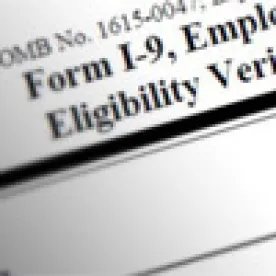The Department of Homeland Security (DHS) recently announced that employers should continue using the current version of Form I-9, Employment Eligibility Verification beyond the expiration date. The current version of Form I-9 states that it expires on October 31, 2022, but DHS is extending this version “until further notice.” In October, DHS also extended its Form I-9 temporary flexibility procedures for deferring physical inspection of documents through July 31, 2023. In part, DHS made these extensions to allow the agency more time to consider major changes on the Form I-9 and in the rules on document verification.
Proposed Changes to Form I-9
In 2022, DHS has prepared various drafts of a new Form I-9 to streamline the contents. Over the summer, DHS posted the most recent draft for public review. Here are some highlights of the proposed changes:
-
Returning § 1 and § 2 to appear on the same page as was done several years ago, rather than on two separate pages as on the current I-9 version.
-
Creating a new Supplement A to contain the Preparer/Translator paragraphs instead of having those paragraphs appear immediately after § 1.
-
Creating a new Supplement B to contain the current § 3 for reverification (and in limited situations rehires).
-
Condensing the current fifteen pages of instructions down to seven pages. For additional information, DHS plans to refer employers to its online Handbook for Employers and I-9 Central website.
-
Eliminating the current requirement that new hires and employers enter “N/A” in §§ 1 and 2 when fields do not apply and holding employers responsible for such errors when the N/A response is not given. With the proposed draft of Form I-9, DHS will allow fields to be left blank if they do not apply.
-
Updating the I-9 List of Acceptable Documents to state that DHS will treat documents as unexpired when the issuing agency has extended those documents beyond the stated expiration date (e.g., driver’s licenses extended by a state department of motor vehicles for a temporary period beyond the date shown on the face of the license).
-
Other formatting changes in presentation of the fields and certain language on the Form I-9.
DHS has received significant resistance to returning §§ 1 and 2 to the same page. DHS previously moved to the current two-page format to define the employee’s section and the employer’s section more clearly and to allow more room for the fields, organized entries, and explanations when needed. Most employers have found the change to two pages helpful to reduce mistakes. Despite the negative comments from employers, DHS appears intent on moving to the one page format. The most recent draft may undergo further changes before the government finalizes the new Form I-9. DHS usually announces the new version of Form I-9 well in advance of making it mandatory. Therefore, employers should have time to transition to the new Form I-9 in an organized and informed manner.
Extending the I-9 Temporary Flexibility Procedures and Considering Alternatives for Document Verification
DHS has extended the Form I-9 temporary flexibility procedures for deferring physical inspection of documents through July 31, 2023. DHS first implemented these flexibility procedures at the start of the pandemic and has granted multiple extensions. As we explained in prior posts, under the flexibility procedures, qualifying employers may conduct a virtual review of the I-9 documents and temporarily defer the physical inspection of those documents. When conducting the virtual inspection, the employer must confirm the remote nature of the inspection in the “Additional Information” field in § 2 of Form I-9. Employers must complete the physical document inspection within three business days after (1) returning to “normal operations” or (2) DHS’s termination of the temporary flexibility procedures, whichever occurs earlier. When the employer completes the in-person physical inspection of the I-9 documents, the employer also should confirm in the Additional Information field.
Although DHS stated that it was extending the temporary protocols to mid-2023 for public health reasons, DHS likely also granted the several month extension to allow the agency time to determine whether to implement a remote verification option permanently. DHS is studying whether the agency can implement such a procedure with sufficient security protections to deter fraud. Immigration and Customs Enforcement (ICE), the division within DHS that enforces the I-9 rules, has insisted on in-person verification as a deterrent to fraud and as the best way to hold the employer accountable on I-9 compliance issues. The introduction of the I-9 temporary flexibility procedures for more than two years has forced ICE to reconsider its view on the ways to fight fraud and ensure employer compliance. ICE recently issued a proposed rule to provide DHS with authority to implement alternative options for document examination. The proposed rule does not outline the alternative options. Instead, this rule confirms that DHS may take various actions regarding I-9 document examination procedures such as:
-
Extending I-9 flexibility protocols
-
Conducting a pilot program to evaluate alternative verification procedures
-
Implementing other verification procedures
-
Taking related actions as appropriate related to document verification for I-9 compliance
If DHS does establish an alternative verification procedure, that procedure may be available only to certain employers. If, in the future, DHS allows remote verification on a long-term basis, ICE may require that employers take additional steps for I-9 compliance. ICE also may require employers to complete additional training on fraud detection. With all these unknowns, for any Forms I-9 covered by the temporary protocols, employers should complete in-person document inspections soon and well before July 31, 2023.
-
For a remote employee who is not working onsite on a regular, consistent, or predictable basis, but who is sporadically coming to the office, the employer should arrange to meet with the employee to complete the physical document inspection.
-
For an employee who works remotely because of the pandemic and never visits the office, the employer should request a special meeting, if possible, to conduct the physical document inspection.
We will continue to provide updates on these developing I-9 issues.




 />i
/>i
